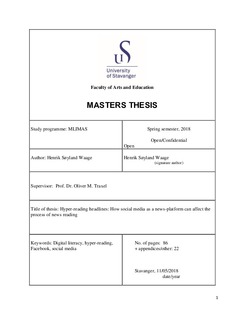| dc.description.abstract | People read differently on digital platform than on print, which can affect the way they interpret and understand what is being read. When reading digitally many people hyper-read, meaning that they skim the material in an attempt to withdraw essential information. This can lead to a shallower reading, with less understanding and reflection on what is being read. Since social media, a digital type of media, is getting increasingly popular as a source of news, the way people read news is changing. In addition to how people hyper-read on digital platforms, social media has also changed the way in which news are presented to people. Facebook is the most popular social media for news, and on here people can be shown material that their Facebook friends react to. In addition, Facebook’s own algorithm suggests and promotes news that the reader is believed to be interested in. This has the potential to lead to both exposure to new viewpoints as well as to the creation of political echo chambers, where people are only shown a limited amount of information. People who hyper-read are unlikely to even click on the majority of articles they see on Facebook and read only the headlines. Of the articles they do click on, around one third of the material is actually read. There is then a risk of social media users severely limiting the quality and scope of information which they read.
This thesis looks at how digital reading differs from traditional reading and how this can affect people’s reading of news, and consequently their use of news reading as a way to understand the world and shape their Weltanschauung. To see if there are major discrepancies between the news stories presented by the nine major U.S.-based news outlets on Facebook, 400 headlines from each of these news outlets has been collected, analyzed and compared. This showed that there are indeed big differences in type of content and type of narrative being presented by the various outlets based on the headlines presented on Facebook. If readers restrict their news reading to one or just a few news outlets, they risk getting little exposure to opposing viewpoints and a limited understanding of the topics they read about. It is possible that social media can contribute to increased political polarization because of the very way in which users read and reflect on digital material, in addition to how social media outlets present news content. | nb_NO |
